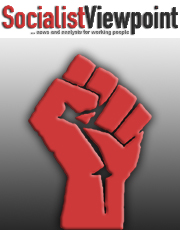Sandy, the Storm from Hell—Unless You’re a Banker
When the bankers take over a nation and its economy they don’t build factories, and they don’t make investments in people or infrastructure. What finance capitalists do, when given the power, is put everyone in debt.
For Wall Street, every disaster is an opportunity to make debt slaves of the victims—if the victims have enough resources to pay back the banks. If those struck by natural calamity are too poor to become assets on the bankers’ books, they’re pretty much on their own—even when a public agency is in charge of disaster relief.
A new report by a group called Strike Debt, described as an offshoot of the Occupy Wall Street movement, says federal disaster aid in the wake of Hurricane Sandy is largely built around ensnaring storm victims in debt. Titled “Shouldering the Costs,” the study concludes that the burden of recovery from disasters is being shifted to the individual. “Federal aid programs,” says the report, “require victims to first apply for loans before qualifying to apply” for aid from FEMA, the Federal Emergency Management Agency. And before the feds will even consider making Small Business Administration loans in a disaster, they require that the victims first go to a commercial bank, where the interest rates are much higher.
To the average citizen, this seems illogical. Why place a hurricane-struck small businessperson in deeper financial trouble by forcing her to take on even more debt? What kind of disaster relief is that? Very good logic, if the intention is the serve the banks. The unwritten rule of government under capitalism is never to compete with private business—even in disasters. Therefore, the first job of government is to withhold low interest federal loans from victims with good credit, in order to protect corporations’ chances to profit from the disaster. Only if the private banks reject you will the Small Business Administration offer “direct loans” at lower rates.
After a victim qualifies for consideration for a federal loan, her “credit-worthiness” remains key. About half the applicants are rejected. Since Blacks and other racial minorities tend to have worse credit ratings than whites, the federal policy has the effect of widening already existing racial disparities. The storm’s impact on Blacks and browns is magnified by federal disaster relief policies.
The Occupy-related activists say FEMA and the Small Business Administration steer homeowners to loan programs, rather than grants. However, many homeowners in the impacted areas were already underwater in terms of their mortgages, and the storm has further devalued their neighborhoods and, therefore, their property. “By only offering loans to already struggling homeowners,” says the report, “FEMA and the SBA shift the burden of disaster to individuals and send profit to the loan servicers…. Homeowners have no way out of these properties other than foreclosure. The only practical option is to take the chance on taking on more debt.”
Although capitalists rant and rail against the public sector, the reality is that the United States government is their loyal servant, always careful to let corporations cherry-pick every possible bit of profit before using public funds to help the people in times of disaster. And even then, the banks will always get their cut.
—Black Agenda Report, December 5, 2012
http://blackagendareport.com/content/sandy-storm-hell-%E2%80%93-unless-you%E2%80%99re-banker


